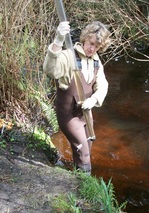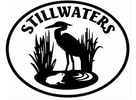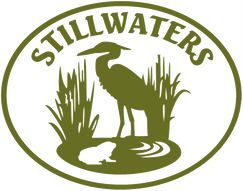Stillwaters Monitoring Program: Citizen Scientists at Work
"We all live downstream." ~David Suzuki

The Cutthroats of Carpenter Creek was formed in 1998 as a program of Stillwaters Environmental Education Center. The group works to protect water quality and fish and wildlife habitat in the Carpenter Creek watershed.
In August 2004, a water quality monitoring plan was written for the estuary. The goal is to restore ecosystem processes in the Carpenter Creek Estuary/Apple Tree Cove. Data collected in the estuary monitoring program adheres to the marine water monitoring standards of the Department of Ecology. Data is also used to educate the public about the importance of water resources and the health of Puget Sound.
In 2011, the Stillwaters Fish Passage was completed. This was the replacement of a 12 foot culvert under South Kingston Rd to a 70' bridge. This improvement allows greater tidal influence and sediment movement which in turn creates a healthier ecosystem for everyone from invertebrates to humans. Stillwaters has been charged with monitoring the various changes happening in the estuary. It is exciting work!
The volunteers collect information on Temperature, Dissolved Oxygen, Turbidity, pH, Fecal Coliform and Salinity. There is also benthic survey work and analysis. As with any scientific endeavor, protocols must be strictly adhered to; these include time, tide and the order in which the tests are done.
In August 2004, a water quality monitoring plan was written for the estuary. The goal is to restore ecosystem processes in the Carpenter Creek Estuary/Apple Tree Cove. Data collected in the estuary monitoring program adheres to the marine water monitoring standards of the Department of Ecology. Data is also used to educate the public about the importance of water resources and the health of Puget Sound.
In 2011, the Stillwaters Fish Passage was completed. This was the replacement of a 12 foot culvert under South Kingston Rd to a 70' bridge. This improvement allows greater tidal influence and sediment movement which in turn creates a healthier ecosystem for everyone from invertebrates to humans. Stillwaters has been charged with monitoring the various changes happening in the estuary. It is exciting work!
The volunteers collect information on Temperature, Dissolved Oxygen, Turbidity, pH, Fecal Coliform and Salinity. There is also benthic survey work and analysis. As with any scientific endeavor, protocols must be strictly adhered to; these include time, tide and the order in which the tests are done.
Your browser does not support viewing this document. Click here to download the document.
Your browser does not support viewing this document. Click here to download the document.
Your browser does not support viewing this document. Click here to download the document.
Your browser does not support viewing this document. Click here to download the document.

